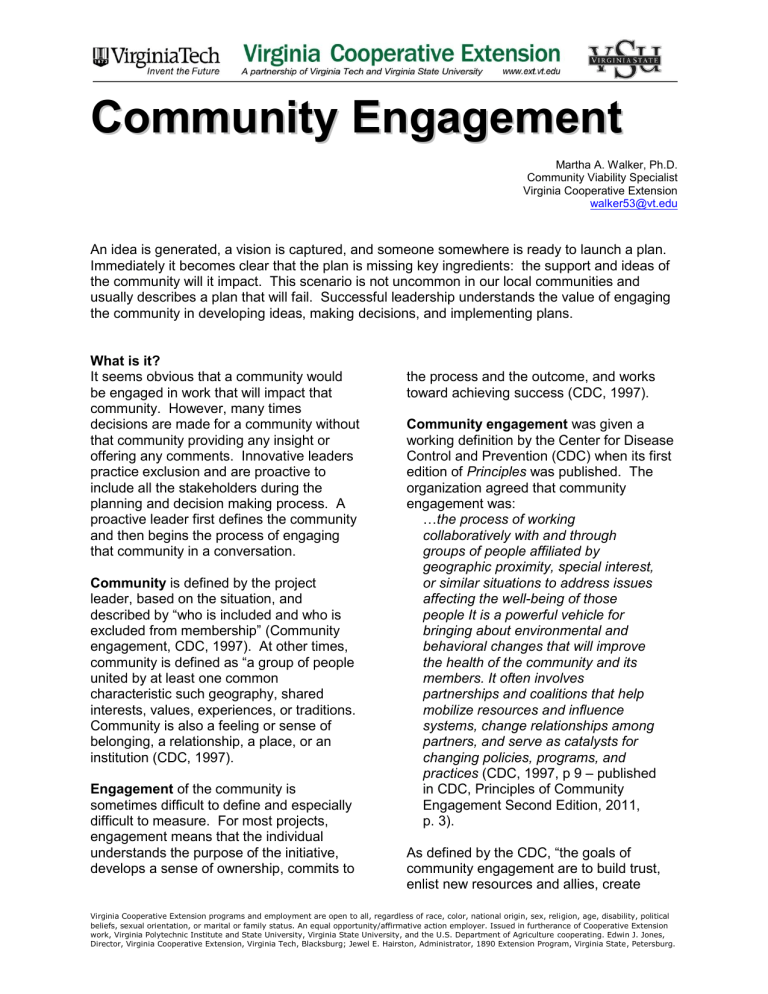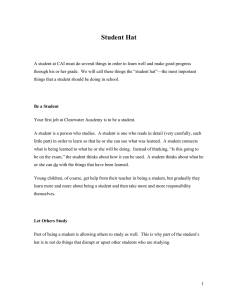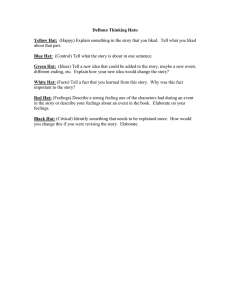Community Engagement: A Guide to Successful Collaboration
advertisement

Community Engagement Martha A. Walker, Ph.D. Community Viability Specialist Virginia Cooperative Extension walker53@vt.edu An idea is generated, a vision is captured, and someone somewhere is ready to launch a plan. Immediately it becomes clear that the plan is missing key ingredients: the support and ideas of the community will it impact. This scenario is not uncommon in our local communities and usually describes a plan that will fail. Successful leadership understands the value of engaging the community in developing ideas, making decisions, and implementing plans. What is it? It seems obvious that a community would be engaged in work that will impact that community. However, many times decisions are made for a community without that community providing any insight or offering any comments. Innovative leaders practice exclusion and are proactive to include all the stakeholders during the planning and decision making process. A proactive leader first defines the community and then begins the process of engaging that community in a conversation. Community is defined by the project leader, based on the situation, and described by “who is included and who is excluded from membership” (Community engagement, CDC, 1997). At other times, community is defined as “a group of people united by at least one common characteristic such geography, shared interests, values, experiences, or traditions. Community is also a feeling or sense of belonging, a relationship, a place, or an institution (CDC, 1997). Engagement of the community is sometimes difficult to define and especially difficult to measure. For most projects, engagement means that the individual understands the purpose of the initiative, develops a sense of ownership, commits to the process and the outcome, and works toward achieving success (CDC, 1997). Community engagement was given a working definition by the Center for Disease Control and Prevention (CDC) when its first edition of Principles was published. The organization agreed that community engagement was: …the process of working collaboratively with and through groups of people affiliated by geographic proximity, special interest, or similar situations to address issues affecting the well-being of those people It is a powerful vehicle for bringing about environmental and behavioral changes that will improve the health of the community and its members. It often involves partnerships and coalitions that help mobilize resources and influence systems, change relationships among partners, and serve as catalysts for changing policies, programs, and practices (CDC, 1997, p 9 – published in CDC, Principles of Community Engagement Second Edition, 2011, p. 3). As defined by the CDC, “the goals of community engagement are to build trust, enlist new resources and allies, create Virginia Cooperative Extension programs and employment are open to all, regardless of race, color, national origin, sex, religion, age, disability, political beliefs, sexual orientation, or marital or family status. An equal opportunity/affirmative action employer. Issued in furtherance of Cooperative Extension work, Virginia Polytechnic Institute and State University, Virginia State University, and the U.S. Department of Agriculture cooperating. Edwin J. Jones, Director, Virginia Cooperative Extension, Virginia Tech, Blacksburg; Jewel E. Hairston, Administrator, 1890 Extension Program, Virginia State, Petersburg. better communication, and improve overall health outcomes as successful projects evolve into lasting collaborations” (CDC, 2011, p. 3). Philanthropic organizations such as the Kellogg Foundation agree that “people have the inherent capacity of solve their own problems and that social transformation is within the reach of all communities.” The Kellogg Foundation clearly states that it seeks engagement through dialogue, leadership development, collaboration, and new models of organizing. It wants to partner with those who are committed to inclusion, impact, and innovation in solving public problems (W.K. Kellogg Foundation). Why is it needed? Engaging a community in the discussion increases everyone’s level of awareness, allows individuals to advocate for their ideas, and offers a format to gather advice or guidance based on the community’s expertise and experiences. Community engagement is needed to guide the development of the project agenda by expanding or redefining the focus of the initiative, identifying unexposed information, and creating a network for revenue sources and funding partners. The diversity and the number of identified stakeholders are increased. Stakeholders are educated on the issue and invited to contribute to the process thereby expanding access to available knowledge and skills. When communities are engaged at the beginning and throughout the project, people appear to a) be more receptive to the outcome, b) have the capacity to implement change, and c) maintain longterm partnerships improves. Engagement of the community should not be utilized when there’s a history of conflict, costs are greater than the benefits, critical stakeholders refuse to participate, agreement is not reached on project goals, or the people accountable don’t really want others involved (Linden, 2002). Who makes it happen? Innovative people who have the vision for what is possible will invite the right people to the table. Hopefully, the project leadership will recognize the value of inclusion and engagement but it is not always the case. A community member may see the connection between a proposed initiative and the community and ask to be included. In other situations, it may be the project consultant who proposes community engagement as part of the process for developing the plan. Elected officials are prime candidates for launching community engagement (Addendum A). What’s the process? Simply knowing that community engagement is beneficial to developing and implementing a project is not enough. Knowledge requires action to create impact. Russ Linden (2002) suggested that certain conditions must be present before collaboration or engagement can occur. Community Engagement Conditions include: Shared and defined purpose. Willingness to collaborate. Commitment to contributing. Participation of the right people. Open and credible process. Involvement of a champion with credibility and clout. Page 2 The engagement process is complex but manageable. Initially the leadership will: Convene a small group to clarify and validate the vision. Discuss and define the initiative and its potential impact. Set the purpose and goals for community engagement. Define the community. Know and respect the community’s characteristics. Develop a relationship with the community, build trust, work with formal and informal leadership, find the community gatekeeper, identify the project champion, meet with the local organizations, and learn the assets and challenges for that community. Find the common interests. With the community defined and a relationship established, the work is ready to continue. The following four phases provide an outline for the community engagement process. Phase I: Set the Stage Invite the stakeholders to a conversation on the vision. Go to the community instead of having the community come to you. Create a constructive environment for dialogue allowing time to get to know the participants remembering that the community’s time is valuable and must be respected. Identify the person or the organization that has convened the group and will provide initial leadership and organizational management until a management/leadership core team is in place. Outline the purpose and process for the conversation. Use a facilitator when appropriate. Define the issue and why it is important. Outline what is broken and focus on what is working. Is the issue a people problem or a situation Community Engagement problem (Heath & Heath, 2010)? Can the problem be solved with technical expertise or will it require something else (The Kettering Foundation, personal communication, March 1, 2011)? Determine the interest and merit in hosting future discussions. Set the next steps if the group wants to move to Phase II. Phase II: Gather the facts, brainstorm, & Select (Addendum B) Create an environment for discussion where people are comfortable asking questions, expressing doubts, and brainstorming new ideas (Linden, 2002). Gather the facts related to the issue and its impact. Use a SWOT, appreciative inquire, asset mapping, and other tools during the factfinding stage. Clarify the issue’s alignment with the community’s values, ethics, vision, and mission. Establish the common ground on which conversations will be based. Brainstorm and gather alternative solutions. Ask the “what if” questions. Spend time discussing the options, the alignment with the vision, and the potential impact. Allow the process to equip the participants to “see the change, feel the change, and then be prepared to change (Linden, 2002). Select the best practice/solution. Use decision-making tools to reduce the number of options. Too many choices may be debilitating (Heath & Heath, 2010). Assess the community’s readiness to move to Phase III. Phase III: Plan and Review Write the implementation action plan. Include the evaluation procedure that will answer the Page 3 question “What will it look like when the change has happened?” (Heath & Heath, p. 69). Discuss the proposal with the appropriate stakeholders searching for insight and response. Use the feedback to assess and revise the plan. Stay focused on the solution. Confirm the community’s readiness to move to Phase IV. Phase IV: Implement and Evaluate Secure required funding, staffing, and management team. Should a coalition be formed ensure there is a distribution of power and recognition always communicating and respecting the partners’ roles. Implement the plan. Remember, groups want a rapid success. Identify an action that will provide a “meaningful win” within the “immediate reach.” Evaluate the impact. Report the status to the community and gather feedback. Revise the plan and evaluate again. (This step may involve any of the previous steps.) Throughout this process communication, diplomacy, patience, and flexibility are essential. The core team must keep the participants informed through discussion agendas, written summaries of previous discussions, goals/assignments for the next discussion, and progress reports providing accountability for delivering what was promised. The CDC developed a chart to outline the characteristics for levels of community involvement related to its health initiatives (Addendum C). This same tool may be helpful in recognizing group behaviors throughout the engagement process. Butterfoss (2002) created a flowchart of the coalition building process (Addendum D) for health programs but it will also apply to community engagement for all types of initiatives. Engaging a community may foster a struggle for control and recognition. This need for power may lead to behaviors that are difficult to manage in group situations. Some may arrive with a self-serving bias where they value their own contribution more than listening to other participants. Engagement is risky when people feel they are losing autonomy of their vision or control of their own turf whether it is space, expertise, or thoughts. Ultimately it is the lack of trust and confidence in the process or in the other participants that will undermine any initiative (Linden, 2002). For every risk that is overcome the rewards are abundant. Individuals are better informed, new resources are discovered, relationships are strengthened, and an environment that enhances the community’s capacity for problem-solving is established. References Butterfoss, F. D. & Kegler, M. (2002). Toward a comprehensive understanding of community coalitions: Moving from practice to theory. In Emerging theories of health promotion practice and research. R. DiClemente, R. Crosby, & M. Kegler (Eds.) pp.157-193). Jossey-Bass. San Francisco, CA.Center for Disease Control and Prevention (CDC). (1997). Community engagement: Definitions and organizing concepts from the literature. http://www.cdc.gov/phppo/pce/ Center for Disease Control and Prevention (CDC). (June 2011). Principles of community engagement. Second edition. http://www.atsdr.cdc.gov/communityengagement/pdf/PCE_Report_508_FINAL.pdf Heath, C. & Heath D. (2010). Switch: How to change things when change is hard. Random House, Inc. New York. W.K. Kellogg Foundation. (2012). http://www.wkkf.org/what-we-support/civic-engagement.aspx Linden, R.M. (2002). Working across boundaries. John Wiley & Sons. San Francisco, CA. National League of Cities. (2011). Beyond civility: From public engagement to problem solving. www.nlc.org http://www.nlc.org/find-city-solutions/research-innovation/governance-civic-engagement/beyond-civility-frompublic-engagement-to-problem-solving Williams, D. (2005). Real leadership. Berrett-Koehler Publishers, Inc. San Francisco, CA. Community Engagement Page 4 Addendum A From public engagement to problem solving: A summary Based on Beyond civility: From public engagement to problem solving. National League of Cities www.nlc.org Martha A. Walker, Ph.D. Community Viability Specialist Virginia Cooperative Extension Should elected officials actually engage and work with residents, civic organizations, and other stakeholders to define the issues and identify the solutions? There are lessons to be learned from the work our cities are doing to engage local residents more effectively in the work of “democratic government.” The National League of Cities (NLC) defines democratic governance as “the art of governing a community in participatory, deliberative, inclusive, and collaborative ways.” If this is the accepted definition, residents, community organizations, businesses, the media, and others have a role in defining the community issue and arriving at viable solutions. The National League of Cities suggested that public engagement is based on seven principles: Model Civility Sharpen skills Opportunities for informed engagement A culture of community involvement Technology application Inclusion Sustainability Principle 1: Model Civility Elected officials may not always provide the best model for engagement. Many times our elected leaders are pressed for time and are struggling with difficult if not impossible circumstances. Under these conditions, leaders have fallen prey to posturing, name calling, and hard-line politics. Local leaders set the stage for public conversations. If the dialogue between members of the Board of Supervisors or the City Council is conducted in a civil and responsible manner, the tone will be set for community conversations. Some elected officials polish their leadership skills through coursework offered by associations. In Virginia, the Virginia Association of Counties (VACo) and Virginia Cooperative Extension offer the Virginia Certified Supervisor Program with courses in budgeting, decision making, governance, community planning, leadership, and board responsibilities. This training along with programs offered by Virginia Municipal League provides a forum for elected officials to discuss processes and responses that would best serve their communities. “Public engagement means to me more than just me speaking to the citizens from our regular meetings . . . It means having roundtable discussions, small and large group forums for us to hear both sides other [problems] and the solution . . . Engagement is just Community Engagement Page 5 another form of communication . . . we need to effectively communicate with one another.” Cynthia Stamps-Jones, Councilmember, Riverdale Georgia Principle 2: Sharpen skills City and county leaders collaborate with professional facilitators, mediators, communications consultants, academics, and others to structure effective processes to engage people in conversation on issues. Furthermore, communities utilize the expertise of universities and other partners to offer training opportunities for local residents that will enhance the residents’ understanding of local government and the resources. Principle 3: Opportunities for informed engagement Elected officials cannot do the work of government alone. It is vital that citizens provide input into the decision making process. However, opportunities for public input are normally provide through the “usual suspects” including public comment sessions before scheduled meetings and public hearings held on a specific topic. To capture the comments of a diverse group, leaders must go to the group equipping the citizens with good information on the issue, defining how the governmental process works, engaging the citizens in candid conversations on the real problem, and generating ideas for solutions. These ideas are then considered as possibilities and are subjected to a due diligence process where the feasibility is considered. Some communities have established an “innovation taskforce” to provide the system for vetting community generated ideas. In other communities, leaders are building better relationships with news media to transition from the “conflict” reporting to a reporting style that educates and engages the public in dialogue on the issues. Dean Williams author of “Real Leadership” challenged leaders to engage community member to “diagnose the deeper nature of the problem and develop workable win-win solutions” (p 50). Real leaders seek new wisdom and will adjust their vision as appropriate (Williams, 2005). “. . . we have to be really careful about the decisions we make because we do not have either the time or the money to misstep . . .so if the public can own that issue and the problem in the beginning and the solution at the end, it make the decision much more sustainable.” Robin Beltramini, Councilmember, Troy, Michigan Principle 4: A culture of community involvement Citizens have a responsibility to the community to be a neighbor. Neighbors engage themselves in numerous ways from keeping the yard clean to watching the neighborhood to volunteering. Most citizens do not know how to work with agencies in their county or city and need the path clearly defined. Local governments want citizens educated on how to be “good citizens.” Systems are established within the local government to host citizen academies, Chambers of Commerce sponsor leadership programs, and Virginia Cooperative Extension offers a grassroots leadership training. Each program is designed to provide the local citizen with effective tools for practicing leadership and engagement within the community and with local leadership. Community Engagement Page 6 Principle 5: Technology application Using social media should not be off limits for cities and counties. Not everyone can attend a face-to-face meeting. Instead people who need other options to engage in dialogue can offer their ideas through interactive technologies. “In June 2010, the Public Technology Institute designated Greensboro, North Carolina, as one of eight “Citizen-Engaged Communities” for its efforts to provide the public with a variety of ways to access services and information via the city’s website and other communication channels” (National League of Cities, 2011, p. 5). Principle 6: Inclusion It is time to open the discussion to all. When a county or city values inclusion, the leaders will review the invitation list and ensure that all ages, genders, races, cultural, geographic, income level, business, religious, and interest groups are represented. It is through the diversity of the participants that new insights will be gathered and more effective and creative strategies will be identified. Principle 7: Sustainability Public engagement must be continuous and not a one-time event. Ensuring this sustainability requires leaders to include the process in the city’s or county’s established committee/taskforce system. A diverse, cross-sector committee of residents and leaders from various segments of the community would be established with a well-defined charge to develop ideas and plans for fostering a higher level of public engagement among local residents around key issues facing the community. This committee might use proven methods such as “community circles” to host small group discussions on specific issues. Questions might be developed to guide civic groups in discussing a topic at a regular meeting, or interview questions might be given to college students to ask residents as they shop. References National League of Cities. (2011). Beyond civility: From public engagement to problem solving. www.nlc.org http://www.nlc.org/find-city-solutions/research-innovation/governance-civic-engagement/beyond-civility-frompublic-engagement-to-problem-solving Williams, D. (2005). Real leadership. Berrett-Koehler Publishers, Inc. San Francisco, CA. Community Engagement Page 7 Addendum B FACILITATION SERIES: The Dynamics of Group Decision Making Martha A. Walker, Ph.D., Community Viability Specialist Crystal Tyler-Mackey, Ph.D., Community Viability Specialist Making a decision is never easy, regardless of whether the responsibility for the final commitment is in the hands of an individual or a group. The decisionmaking process is packed with numerous components requiring the decision makers to invest time in defining the issue and gathering the facts. Because decisions reflect the values of a group, facilitators work with the group to clarify its values and build its vision in alignment with its mission. Through the discussions, facilitators will capture many ideas and solutions for the defined issue. If a group eagerly accepts the ideas generated during face-to-face discussions without exploring alternative solutions, the group will fall short of achieving the excellence it deserves. Therefore, a facilitator will always encourage the group to examine other promising ideas, review the successes accomplished by other groups facing similar situations, and develop a plan based on the best options. the planning process where ideas are transitioned into goals, objectives, and strategies. Within the implementation plan, the facilitator will encourage the group to identify who will be responsible for implementation and set deadlines for the projects. Evaluation is an ongoing part of the plan where you are always asking what was accomplished and what difference did it make. The following list outlines the steps guiding the decision-making process: Create a constructive environment for dialogue. Define the issue. Gather the facts. Clarify the issue’s alignment with values, ethics, vision, and mission. Search for alternative solutions. Select the best practice/solution. Design the implementation plan of action. Implement the plan. Evaluate/assess the impact. Revise the plan and evaluate again. (This step may involve any of the previous steps in decision making.) The end of the decision-making process is actually the beginning of Community Engagement Page 8 Tools for Decision Making In order to accomplish these steps, facilitators will take specific actions. The following chart provides a facilitator with guidelines for each phase of the process. Task Creating a constructive environment. Strategy Involve stakeholders in an honest dialogue on the issue. Action Defining the issue. Investigate surface issue(s) and underlying issues. Select an impartial, competent (skilled) facilitator/leader. Understand the stages of group development. Identify individuals/groups affected by the issue. Design a non-threatening room arrangement. Design the process. Establish trust. Engage in conversation through active listening and questioning. Blue Hat questioning (see Attachment 1). Clarify vision and goal. Utilize tools such as Starbursting, 5 Whys, and SWOT analysis (See fact sheet Facilitating Group Discussions: Generating & Narrowing Ideas and Planning for Implementation). Gathering the facts. Clarifying the alignment with personal, organizational, and community values. Identifying and selecting the solution. Community Engagement Utilize existing data. Identify missing information. Research multiple sources. White Hat questioning (See Attachment 1). Review all documents and other resources. Visit site (if appropriate). Listen to stakeholders. Confirm the issue fits the level of consideration. Consider referral to another entity/ department/office. Present multiple options for consideration. Examine pros and cons. Avoid “group think” (desire for consensus which overrides need for best thinking). Review vision and mission statements. Assess ethical position. Confirm issue is appropriately assigned. Utilize Reframing Matrix. Green Hat questioning (See Attachment 1). Brainstorming. Yellow Hat questioning. Black Hat questioning. White Hat questioning. Red Hat questioning. Search for common themes using Affinity diagrams (See fact sheet Facilitating Group Discussions: Generating & Narrowing Ideas and Planning for Implementation). Page 9 Use visual tools to frame the options: Brain mapping, Fishbone diagram, Pair Comparison, logic model. Define the pros and cons: Force Field Analysis. Developing the action plan. Utilize a planning process with accountability. Prioritize actions. Establish timeline. Identify individual who will be held accountable. Implementing the plan. Manage timelines and reporting requirements. Place report dates on organizational agenda. Read prepared reports. Question responses. Communicate with stakeholders. Assessing the impact. Revising the plan. Evaluate every aspect of the implemented plan. Determine the impact/effect on the original stated problem. Report other outcomes of the implemented plan. Improve the plan based on the assessment report. Terminate the plan when goals have been realized. Seek quantifiable data when appropriate. Look for transformation (change in behavior, attitude, and response). Ask what other effects the plan may have had. Revisit the issue seeking better ways to address the problem. Green Hat questioning. Yellow Hat questioning. Black Hat questioning. White Hat questioning. Red Hat questioning. Know when to adjourn. References: de Bono, E. (1999). Six Thinking Hats. Little, Brown and Company. Boston. Haskell, J.E. & Cyr, L.F. (2007). Strengthening Your Facilitation Skills. University of Maine with training offered by Virginia Cooperative Extension. Hogue, T. & Miller, J. (2000). Effective collaboration: Strategies for pursuing common goals. Longmont, CO: Rocky Mountain Press, www.rmleadership.com. Kaner, S. (1996). Facilitator’s Guide to Participatory Decision-Making. Gabriola Island, BC: New Society Publishers, nsp@island.net). W.K. Kellogg Foundation. (2004). Logic Model Development Guide. http://www.wkkf.org/Pubs/Tools/Evaluation/Pub3669.pdf Kelsey, D. & Plumb P. (2004). Great meetings: Great results. Portland Maine: Hanson Press. MDC. (n.d.). RCCI: Leadership for change. http://www.mdcinc.org/docs/education_pub_leadership.pdf MDC. (1998). Moving from vision to action: A planning guide for the Rural Community College Initiative. Chapel Hill, NC: MDC, Inc. MindTools http://www.mindtools.com/pages/article/newTED_07.htm Community Engagement Page 10 Attachment 1 Six Thinking Hats Compiled by Martha A. Walker, Ph.D. Community Viability Specialist Individuals and organizations want to be creative and develop ideas that effectively address pressing issues and opportunities. Edward deBono developed the Six Thinking Hats method to guide participants in managing the confusion intense thinking creates and published his parallel thinking concepts in 1985. Six Thinking Hats creates a common sign language for thinking through issues and creating viable action plans. White Hat focuses on available data (facts and figures) while remaining neutral. Participants are encouraged to review existing information, search for gaps in knowledge, analyze past trends, and extrapolate key learnings from historical data. Questions What information do we have? What information do we need? What information is missing? What questions do we need to ask? How are we going to get the information we need? Is it fact or belief? Red Hat uses intuition, gut reaction, and robust emotion. It encourages participants to think about how other people will react emotionally and try to understand the responses of people who do not fully know your reasoning. Participants do not need to explain or justify individual expressions of feelings. Questions How do you react to this? What is your intuition/opinion about this? Gut feelings . . .Hunches or insights . . .Likes/dislikes? What emotions [fear, anger, hatred, suspicion, jealousy, or love (deBono, 1999, p.53)] are involved here? Black Hat is the basis of logical, critical thinking offering careful, cautious, and defensive insights. Try to see what is Community Engagement wrong; why it might not work; what are the dangers, problems, and obstacles; what are the deficiencies in the thinking process. It allows you to eliminate the negatives, alter plans, or prepare contingency plans to counter any problems. Questions What will happen if we take this action? What can go wrong if we proceed with this idea or implement this suggestion? What are the weaknesses that we need to overcome? How does this “fit” with our (or other’s) experience, policy, strategy, values, ethics, and resources? How will people respond? Will it work . . . be profitable . . be acceptable? Black Hat thinking is not an argument, but helps to make plans “tougher” and more resilient. It can help to spot fatal flaws and risks before you embark on a course of action. There is a danger of overusing black hat thinking by remaining in the critical mode and delaying green and yellow hat thinking. Yellow Hat is a deliberate search for the positive (optimistic viewpoint) through exploration and speculation, defining the benefits of the decision and the value in it. Yellow Hat thinking is constructively blending “curiosity, pleasure, greed, and the desire to make things happen” (deBono, Page 11 1999, p. 91). The goal is to enhance the proposal by generating alternative ideas “based on experience, available information, logical deduction, hints, trends, guesses, and hopes” (deBono, 1999, p. 98). Questions What ideas, suggestions, or proposals are there for how to approach this problem? . . .to achieve this goal? What is the merit of the approach? What positives can you see in this idea? What could be done to make this work better? Faster? More economically? Under what conditions could this work? What would it take to make this proposal acceptable? What is your vision for how this could work? Green Hat stands for energy and creativity. This is where you generate new, innovative ideas and develop creative solutions to a problem. It is a freewheeling way of thinking in which there is little criticism of ideas, and “movement” is made using provocation to move “forward with an idea or from an idea” (deBono, 1999, p.125) seeking alternative solutions. Green Hat thinking must involve shaping the idea for the user or “buyer”. Questions Let’s think “outside the box.” What are some fresh ideas or approaches? This is the time for any wild or crazy or “far out” idea. What are all of our alternatives here? Aren’t there some other alternatives . . . perhaps too outside the box? This idea won’t work in its present form, but can we shape it or adapt it so that it might be usable? We’ve always done it this way; let’s “green hat” it . . .does it have to be done this way? Community Engagement Blue Hat is process control “thinking about thinking”. This is the hat worn by people chairing or facilitating the session. Blue Hat may be used at the beginning of the session to set the agenda or the sequence for using the “hats” and at the end of the session when seeking a summary and next steps. Blue Hat focuses on questioning (fishing and shooting – deBono, 1999, p.153) and provides the structure for use of other hats and other thinking/problem-solving tools Questions: Define Issue and Process What is the problem? Is this the real problem? What is the underlying problem? Why do we need to solve this problem? Where should we go first? Where do we start? What should we be thinking about? Assessment of the Process Are we getting anywhere? What factors should we consider? What sort of outcome would we regard as successful? What have we achieved so far? Management/Facilitation Could you put on the “X” hat? You’re not using the “X” hat Page 12 Addendum C Increasing Level of Community Involvement, Impact, Trust, and Communication Flow Outreach Consult Some Community Involvement More Community Involvement Involve Better Community Involvement Collaborate Community Involvement Communication flow is bidirectional Communication flows from one to the other, to inform Communication flows to the community and then back, answer seeking Communication flows both ways, participatory form of communication Provides community with information Gets information or feedback from the community Involves more participation with community on issues Entities share information Entities cooperate with each other Entities from bidirectional communication channels Outcomes: Develops connections Outcomes: Visibility of partnership established with increased cooperation Outcomes: Partnership building, trust building Entities coexist Outcomes: Optimally, establishes communication channels and channels for outreach Forms partnerships with community on each aspect of project from development to solution Shared Leadership Strong Bidirectional Relationship Final decision making is at community level Entities have formed strong partnership structures Outcomes: Broader health outcomes affecting broader community. Strong bidirectional trust built Source: Center for Disease Control and Prevention (CDC). (June 2011). Principles of community engagement. Second edition. http://www.atsdr.cdc.gov/communityengagement/pdf/PCE_Report_508_FINAL.pdf Community Engagement Page 13 Addendum D Community Coalition Action Theory (CCAT) Processes Lead Agency/ Convener Group Coalition Membership Collaborative Synergy Leadership & Staffing Structures Member Engagement Pooled Resources Assessment & Planning Implementation of Strategies Community Change Outcomes Community Capacity Formation Maintenance Health/ Social Outcomes Institutionalization Source: Butterfoss, F. D. & Kegler, M. (2002). Toward a comprehensive understanding of community coalitions: Moving from practice to theory. In Emerging theories of health promotion practice and research. R. DiClemente, R. Crosby, & M. Kegler (Eds.) pp.157-193). Jossey-Bass. San Francisco, CA. Community Engagement Page 14





